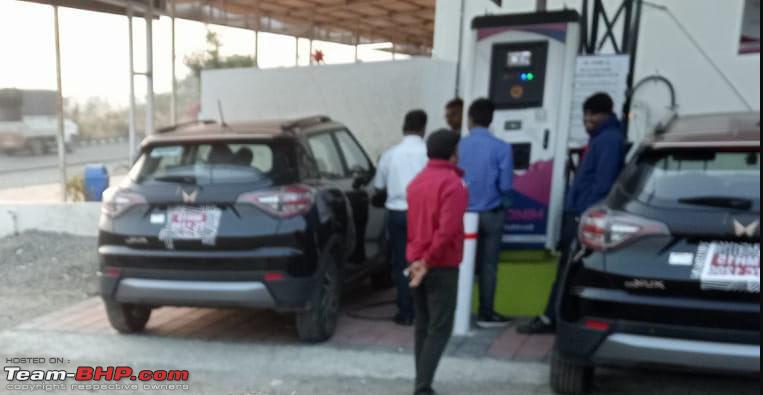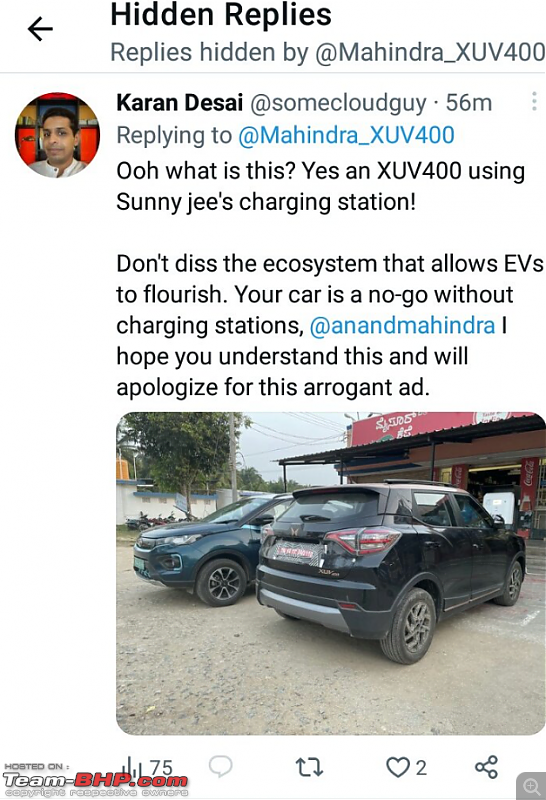Quote:
Originally Posted by vtires2018  -- Somehow I disagree on living with range anxiety, can you please share your research that increasing battery capacity to 50 - 60 kWh do not have substantial increase in range.
Remember the EV sales will be high in 2023, and more cars using 35kWh will have to use outside (expensive) charging, if their real world range is 250 -320 KM.
My perspective was with higher battery (50-60 kWh ) then less dependency on outside charging, as well as cheaper overall, no range anxiety for the family. Also bigger batteries would suit more EV adoption by Taxi operators.
Also not sure, how is actual usable battery from which range is generated.
60 kWH gives 420 KM WLTP (possibly higher limit of 460 KM in India)
50 kWH gives 320 KM WLTP (possibly higher limit of 350 KM in India)
|
Second time in as many days someone is prompting me to "Remember" in this thread. Did someone tell here that I suffer from Alzheimer's or something?

"Research" in bold letters, seriously? You could have asked for the 'calculations' in ordinary font.
Anyway, now we have some real world numbers.
Petrol Nexon kerb weight: 1255 kg
Petrol Nexon kerb weight without engine (100 kg) and gearbox, petrol tank (100 kg) : 1050 kg (appx)
Nexon EV prime kerb weight (30 kWh): 1400 kg (source: brochure)
Less the weight of EV motor (30 kg appx): 1370 kg.
Weight of battery pack @ 7.25 kg per kWh: 225 kg.
Weight of Nexon EV prime without Motor and battery pack: 1150 kg (appx)
Autocar India real world range of Nexon EV prime: 201 km in highways and 216 km in city (Link:
https://www.autocarindia.com/car-new...plained-420958)
Mileage of Nexon EV prime in city (better of the two numbers): 216/30 = 7.2 km/kWh
Nexon EV max kerb weight: 1500 kg (as per brochure)
Predicted real world range in city based on Nexon EV prime's data: (7.2*40)*1400÷1500 = 268.8 kms
Predicted mileage : 268.8 ÷ 40 = 6.72 km/kWh
Actual real world range of Nexon EV max: (source: Autocar India. Link:
https://www.autocarindia.com/car-new...plained-424488) Inside City: 266 km. On highways: 259 kms.
Mileage 266÷40 = 6.65 km/kWh
So our predictions have been accurate. So we can extrapolate further.
Hypothetically, if Nexon EV Max has a 60 kWh battery (there is absolutely no additional space to house the battery. But let us assume that we keep the additional battery sacrificing the boot as in CNG cars; additional 145 kg for the battery @ 7.25 kg/kWh) , then, the city range would be
(60*6.65)* 1500/1645 = 364 kms.
Here the mileage would be 364/60 = 6.066 km/kWh.
So, we can see Nexon EV prime with a range of 216 km with a 30 kWh battery (@7.2 km/kWh), will achieve only a range of 364 kms with a 60 kWh battery (@ 6.066 km/kWh)
So there is a 20% drop in mileage too.
This mileage is exactly the same as Hyundai Kona (similar in size to Nexon) tested by Autocar UK . (Link:
https://www.autocar.co.uk/car-news/n...al-world-range). Hyundai Kona has a 64 kWh battery pack and delivers a real world range of 250 miles (400 kms) @ 6.25 km/ kWh. Hence our calculations are accurate.
In real world it is impossiblle to accommodate a 60 kWh battery pack in a sub 4 meter car like Nexon. Any Addition in length will lead to additional mass too.
Ideally Nexon sized cars can only hold a maximum of 40 kWh battery pack (both in terms of volume and weight)
A creta/seltos sized car can hold a maximum of 60 kWh battery (similar to Kona, BYD Atto 3 etc)
It will require a car of a size of Harrier or above to have the structural strength and the necessary space to accommodate a battery bigger than 70 kWh.
Let us take another bigger car, Harrier, from the Tata stable for such a calculation (though one size bigger than Hyundai Kona)
Harrier kerb weight: 1655 kg
Difference in weight between diesel Nexon and Nexon EV max (40 kWh): 200 kg
Hence, hypothetical weight of Harrier EV with 40 kWh battery+ Motor: 1655+200 = 1855 kg
Same Harrier EV with 60 kWh battery (additional kWh @ 7.25 kg/kWh) = 1855+145 = 2000 kg.
The real world range of a (hypothetical) Harrier with 60 kWh battery: 364 x 1645 /2000 = 299.4 kms (@ 4.99 km / kWh)
Extrapolating this to see the real world range of a Harrier EV with a 90 kWh battery (additional 222.5 kg weight for the battery pack) : (4.99 * 90) x 2000/2222.5 = 404 kms (@
4.49 km/kWh)
Bingo! This is the exact real world range of Jaguar I Pace (similar size of Harrier) with a 90 kWh battery pack (250 miles/404.8 km). Source: Autocar UK ( Link:
https://www.autocar.co.uk/car-news/n...al-world-range)
Hence, irrespective of the size of the car, a real world range of 500 kms or more is near impossible to achieve with the existing battery technology, and when achieved just for the sake of it, it will be terribly inefficient, break the car down with it's weight, and will be comparable to existing petrol hybrids and diesel engines in cost per km.
I.e, only with a 125 kWh, Harrier EV can reach a real world range of 500 kms. Here the battery pack alone will weigh more than 900 kgs, which is the equivalent of 13-14 full grown adults occupying the car, apartfrom the *real* driver and passengers. This will have a mileage of only4 km/kWh which is 45% less than a 30 kWh battery powered Nexon (7.2 km/kWh). If this vehicle is going to get charged with a fast charger at commercial rates (@Rs 12-15 / kWh), suddenly Petrol hybrids and diesels start making a lot of sense, despite the exorbitant taxes.
So a larger real world range requires a larger battery, a larger space, stronger chassis, axle, larger wheels, better brakes and better safety features to reduce the braking distance. All these are not exactly cheap.
Finally, the elephant in the room: battery cost.
In a Hyundai Kona, cost for replacing the 40 kWh battery pack is Rs 11.9 lakhs (source: TBHP. Link
https://www.team-bhp.com/forum/elect...nership-5.html (Hyundai Kona Electric @ 1,00,000 km | Cost of ownership))
Similarly, the cost of replacing the 30 kWh battery pack in Nexon is between Rs 7-9 lakhs (based on different sources).
Hence the cost of a 60 kWh battery alone will be between 15-18 lakhs. Hence suddenly BYD Atto 3 with a 60 kWh battery pack for Rs 33.9 lacs makes a lot of sense and XUV
400 EV base variant with a 34.5 kWh battery pack for Rs 15.99 looks like a steal, even after the price "rationalisation" for Nexon EV prime. (Which is 20 cm smaller in length and with a battery pack which is smaller by 4.2 kWh).
Thanks.
P.S: Don't worry about fitting in bigger batteries inside your cars. Inductive charging (charging while driving) is the way to go!
 (12)
Thanks
(12)
Thanks
 (1)
Thanks
(1)
Thanks
 (1)
Thanks
(1)
Thanks
 (4)
Thanks
(4)
Thanks
 (3)
Thanks
(3)
Thanks
 (1)
Thanks
(1)
Thanks
 (1)
Thanks
(1)
Thanks
 (1)
Thanks
(1)
Thanks
 (1)
Thanks
(1)
Thanks
 (1)
Thanks
(1)
Thanks









